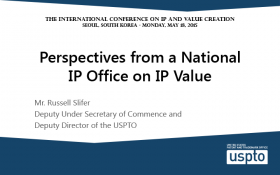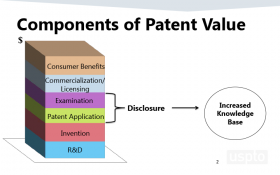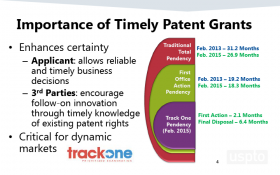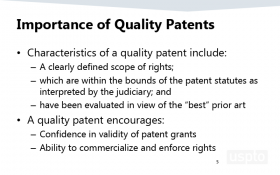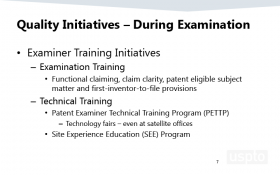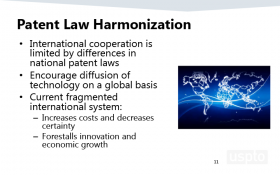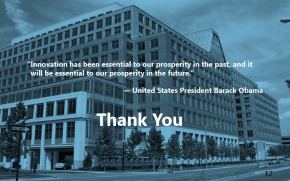The International Conference on Intellectual Property and Value Creation
Korean Intellectual Property Office
Deputy Under Secretary and Deputy Director Russell Slifer
May 18, 2015
10:30 – 12:10 p.m.
Imperial Palace Seoul
Download all slides (PDF)
Before I begin, I would like to thank the Korean Intellectual Property Office (KIPO) and Korea Institute of Intellectual Property (KIIP) for their kind invitation to speak at this event.
Slide 1: Introduction
I am glad to be able to help celebrate this important milestone in Korea’s history, marking the 50th annual innovation day.Commemorations like this not only highlight the importance of innovation in Korea, but illustrate a global culture that understands the importance and appreciation of scientific discovery and technological advancement.
I am also delighted to be presenting with my esteemed Japan Patent Office and European Patent Office counterparts, Deputy Kihara and Vice-President Lutz.
Slide 2: Components of Patent Value
As we talk today about maximizing the value of patents, we must keep in mind that many components contribute to a patent’s overall value. I have listed several of these components on slide 2. You will note that a Patent Office affects only two of the listed components, namely the patent application and the examination thereof. Accordingly, today I will discuss how a national IP office can strengthen the value of a patent with respect to these two components.
Slide 3: Presentation Overview
Specifically, my presentation will focus on how a national IP office can strengthen the value of a patent by ensuring the office issues well-defined property rights in a timely manner and provides mechanisms to redress unrealized patentability concerns.
I will begin with a brief discussion of the importance of timely issued patents followed by initiatives we are currently undertaking at the USPTO to continue to improve the quality of our issued patents.
Afterwards, I will discuss how collaboration between counterpart foreign offices can enhance both the timeliness and quality of patents issued by all participating offices.
Slide 4: Importance of Timely Patent Grants
The USPTO recognizes the importance of reducing both patent pendency and the excess inventory of unexamined patent applications; each of which affect the delivery of innovative goods and services to market.
In particular, the timely issuance of patents enhances legal certainties not just for patent applicants, but also for 3rd parties looking to enter prospective markets.
For patent applicants, when an office makes patentability decisions in a prompt and predictable manner, applicants are able to confidently make business decisions regarding their inventions.
For 3rd parties, prompt examination also provides timely notification about granted rights that can encourage follow-on innovation, licensing opportunities, or even prevent significant investment capital in a potentially infringing product.
As you can see illustrated here, on average, the total amount of time it takes to finally dispose of an application from start to finish, also known as “Total Pendency,” is 26.9 months as of February 2015. This number is down from 31.2 months as measured in February 2013.
Moreover, as of last February it took on average, 18.3 months to receive an initial patentability determination, or “First Office Action”, compared to approximately 19.2 months from February of 2013.
This decrease in pendency is occurring in spite of an average of approximately 4% increase in filings each year.
The current plan is to further reduce those periods to 21.0 and 11.3 months, respectively, by FY 2018.
Further, examination pendency is crucial in dynamic markets where the length of a market advantage is very short due to quick advancements in the underlying technology.
This is one reason why we also created the Track One Initiative, which allows applicants to pay a fee to request prioritized examination and receive a final disposition within twelve months from filing – which as of February, was in fact only 6.4 months until a final disposition.
Slide 5: Importance of Quality Patents
The importance of high quality patents cannot be overstated. A quality patent must clearly define the scope of the patent rights therein, which are within the bounds of the patent statutes as interpreted by the courts and must provide certainty as to its validity over prior art. These factors not only encourage confidence in defending a patent against validity challenges, but in turn, increase opportunities for product development, licensing and other type of commercialization. Accordingly, I will now highlight some of the quality initiatives we are implementing at USPTO.
Slide 6: Quality Initiatives – Prior to Examination
We all know a well drafted patent application – in other words, an application that is clear about the scope of the invention – enhances the ability of patent examiners to perform a quality examination. We are therefore engaged in initiatives to enhance the clarity of the applications that are filed with the USPTO – even before they reach an examiner.
One such program is the Glossary Pilot Program. In this program applicants in certain fields of art use glossaries in patent specifications to define claim limitations. Further, quality examination occurs when the patent application is evaluated in view of the “best” prior art that is available.
One of our quality initiatives promotes this important practice by relying on crowdsourcing – in the form of “microtasking.”
This means leveraging the public to enhance one aspect of the patent examination process – in this case, identifying prior art.
The “Third Party Pre-issuance Submission” initiative provides a mechanism for third parties to submit patents, published patent applications, or other printed publications of potential relevance to a patent application along with a concise description of the asserted relevance of each document submitted.
In this way, the public may take an active role in ensuring that only quality patents are granted. Further, we recently started a new supplementary initiative that enhances the public’s ability to use the third party submission process.
The Patent Application Alert System, released in February 2015 through a partnership with Reed Technology and Information Services, allows a public user to receive a customized email alert when a patent application of interest to the user is published. This alert enables them to be better poised to potentially submit prior art into the application via a pre-issuance submission.
Slide 7: Quality Initiatives – During Examination
High quality patent examination can only be performed by a well-trained examination corps.
In FY 2014, the USPTO conducted extensive patent examiner training on important matters including: functional claiming; claim clarity; patent eligible subject matter; and the first-inventor-to-file statutory provision.
By providing effective training not just at the start of an examiner’s career, but throughout, the USPTO further enhances examiner’s abilities with respect to patent examination fundamentals, legal nuances, communication, and cooperation with applicants.
It is also critical for patent examiners stay on top of the latest trends in the technology fields they are examining. To meet this need we have asked our industry stakeholders to share their knowledge with our patent examiners in order to keep them updated on the latest technologies and innovations in their field of examination.
We currently have two types of technical training programs. The first is the Patent Examiner Technical Training Program (PETTP) where scientific and technical experts from the public are invited to speak at our various campuses and share their experiences with our examiners. The second program is the Site Experience Education (SEE) Program. Under this program, our examiners travel to commercial, industrial, and academic institutions within the continental U.S. and receive specific, hands-on training on the technology areas in which they examine.
Slide 8: Quality Initiatives – Post Examination
For many years the USPTO has offered ex parte re-examination as a means for a patent owner to vet their own issued patents and redress any potential quality concerns.
This is most common when a patent owner becomes aware of prior art not considered during the prosecution of the original application. By filing an ex-parte reexamination, a patent owner is able to either confirm the validity of the original issuance or narrow the scope of the invention such that it may be able to stand up to later challenges – thereby becoming a stronger property right.
Another way we are addressing quality of patents after issuance is through our new Patent Trial and Appeal Board administrative trial proceedings. These proceedings provide a fast and affordable way to test the validity of issued patents and in turn enhance the value of patent ecosystem in two distinct ways. First, patents that are affirmed at these proceedings may be viewed as stronger and more valuable when they are later enforced or offered for license. Second, when a patent is found to be invalid, the board is able to remove that “bad-apple” from the market and allow now legitimate use to flow from that technology.
Slide 9: Popularity of PTAB Trial Proceedings
As of late-April 2015, the Board had received more than 2,800 inter partes reviews and more than 320 covered business method petitions. We’ve also just recently received our first requests for post grant review trial proceedings as patent applications that were filed after the America Invents Act went into effect are beginning to be issued.
The number of petitions for board proceedings even rival the number of cases filed with some traditionally popular federal courts. In 2014, more petitions were filed with the board than any single federal court – and for good reason. Whereas litigation in federal court can take an average of 2.5 years to even get to trial and can cost millions of dollars, the Board is able to hand down final decisions within 12 months at a fraction of the cost of a complete trial.
Slide 10: Work Sharing – Patent Prosecution Highway (PPH)
While we are busy exploring ways to better measure and improve the quality of issued patents domestically, we also recognize the benefits we can achieve by actively engaging with our international counterparts.
For example, the USPTO works with other Intellectual Property offices around the world to develop comprehensive work sharing initiatives. Work sharing is the exchange of search and examination results for related patent applications between various international IP offices.
This exchange of information between offices enhances examination of the applications while at the same time reducing costs to the applicant. One important international work sharing effort is the Patent Prosecution Highway program, or PPH. Under the PPH system, when a first patent office finds an application to be allowable, the applicant may request fast-track examination of a corresponding application at second patent office.
By reusing the search and examination results from the first office, the second office can avoid duplication of work, speed up its examination of the corresponding application, and improve examination quality.
As of June 2014, almost 45,000 PPH requests had been filed in various countries. The largest PPH program is the Global PPH which was created in January 2014. The Global PPH now has 19 members around the world and continues to grow as countries and applicants alike realize the benefits of the PPH system.
Slide 11: Patent Law Harmonization
Although we’ve found great success in work sharing initiatives, international cooperation is still limited by differences in national patent laws. An internationally harmonized patent regime would lead to great diffusion of technology on a global basis.
The current fragmented system leads to increased costs and decreased certainty. Applicants are currently required to amend their applications to meet the laws and procedures of each patent office at which they choose to apply. These increased costs are likely to result in limiting product expansion into new markets – a true measure of the value of IP.
This is why we are committed to working with our international counterparts to create a better system that improves access to technology, lowers costs, and streamlines procedures.
Slide 12: Conclusion
In closing, each of the initiatives I have discussed today helps our Office strengthen the value of U.S. patents by issuing well-defined property rights in a timely manner.
Thank you for your time and attention. It was a pleasure to speak with this group. I look forward to answering your questions during today’s panel discussion.


